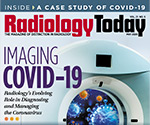 |
In the wake of the COVID-19 pandemic, it’s no surprise that many societies are opting for virtual meetings. One of the most recent is SNMMI, which shifted its annual meeting from mid-June to July 11–14 and adopted a virtual format. The meeting will be free to all members and discounted for nonmembers. Although society members won’t be sharing personal space, they will still have the opportunity to share news and research that is likely to have a profound influence on medical diagnosis and treatment in the coming years. We’re providing a sneak peek at some of that research in this month’s newsletter.
Which molecular imaging developments do you think will have the most far-reaching effects? Let us know on Twitter and/or Facebook.
— Dave Yeager, editor |
 |
 |
Molecular Imaging Provides Early Insight Into Neuroendocrine Tumor Outcomes
A proof-of-concept study recently published in The Journal of Nuclear Medicine has demonstrated that molecular imaging can be used to identify early response to 177Lu-DOTATATE treatment in neuroendocrine tumor patients. Utilizing SPECT imaging with 111In-antiγH2AX-TAT, researchers were able to visualize a DNA damage response marker just days after 177Lu-DOTATATE treatment. Monitoring the DNA damage response in the early days after the radionuclide injection could allow physicians to determine the therapeutic outcome and adapt the therapy regimen accordingly.
The radiobiologic aspects of 177Lu-DOTATATE, as well as other molecular radiotherapies, are underexplored. Radionuclide therapy is largely delivered to neuroendocrine tumor patients on a fixed dose protocol, regardless of body weight or tumor uptake. To justify any increase or decrease in the prescribed radionuclide dose, a sustainable metric is needed; however, no metric currently exists.
“One strategy to develop this metric is to determine if sufficient damage has been done to the tumor, which would allow treating physicians to tailor subsequent doses to ensure therapeutic success,” says Bart Cornelissen, PhD, an associate professor in the department of oncology at the MRC Oxford Institute for Radiation Oncology at the University of Oxford in the United Kingdom. “In our study, we sought to image the molecular biological effects of 177Lu-DOTATATE radionuclide therapy by visualizing the DNA double-strand break damage response marker γH2AX.”
Full story » |
 |
 |
Imaging COVID-19
As a worldwide pandemic shapes the health care landscape, radiologists are doing their fair share, compiling real-time imaging repositories and adapting AI algorithms to save precious time. Read more »
A Picture of Sadness
The blossoming field of psychoradiology is showing that radiologists can substantially contribute to the diagnosis of patients with depression and related mental issues. Read more »
Alternate Routes
Considerable attention is being paid to safety, economy, and scale in the cath lab. We’ll bring you the latest on developments and prospects. Read more »
Down to Specifics
Theranostic innovations involving prostate-specific antigens figured prominently at SNMMI 2019, and recent initiatives are advancing the narrative. Read more » |
 |
 |
| Radiology Today's online gift shop features a wide variety of items for radiology professionals. Choose from t-shirts, journals, clocks, buttons, mouse pads, and much more! Check out our secure online shop today or call toll-free 877-809-1659 for easy and fast ordering. |
 |
 |
Have a product or service you want to market to radiology professionals or an open position that you need to fill quickly? Radiology Today offers many flexible advertising programs designed to maximize your results. From print advertising to e-newsletter sponsorships, website advertising to direct mail opportunities, Radiology Today helps achieve your goals. Email our experienced account executives today for more information or call 800-278-4400!
Coming up in our next issue is our Summer Showcase. Contact sales for more information.
Jobs.AlliedHealthCareers.com is the premier online resource to recruit radiology professionals. Post your open positions, view résumés, and showcase your facility's offerings all at Jobs.AlliedHealthCareers.com!
Radiology Today's Physician
Recruitment Center gives physician recruiters a powerful tool to satisfy their current needs. An ideal option for recruiters looking to fill partnership opportunities, academic appointments, and hospital staff positions, the Physician Recruitment Center is visited regularly by radiologists and other imaging physicians during their frequent trips to our website for the best coverage of industry news and trends. |
 |
|
|
 |
|
|
 |
 |
Advanced Imaging Reverse-Engineers Color of Faded Artifacts
According to personnel at the University of Sydney, whose vibrational spectroscopy facilities are reportedly the most comprehensive in Australia, advanced imaging technology can vividly depict the original colors of ancient Egyptian coffins. The results, they say, afford considerable insight into the study of ancient burial customs.
PA Legislature Urged to Pass Medicare Access to Radiology Care Act
In a brief but thought-provoking statement in the Pittsburgh Post-Gazette, Helen Bradley, RT(R)(VI), ARRT, president of the Pennsylvania Society of Radiologic Technologists, argues in favor of legislation that would require Medicare to recognize and reimburse the much-needed services of radiologist assistants.
Nanoscale Technology Harnesses Interior Cellular Data
Purdue University researchers have made strides in 3D nanoscopy, a procedure that, the study authors say, improves upon super-resolution fluorescence microscopy. The new method addresses a longstanding problem—namely, that light permeates various cellular and tissue regions at inconsistent speeds, per an article in Nature Methods.
Research Suggests Retinal Enhancement Can Bestow Infrared Vision
SPIE, the international society for optics and photonics, checks in on a mouse model that utilizes specialized nanoparticles to enhance the retina, thereby extending natural vision to include infrared light. Further information on the study is documented in Cell. |
 |
 |
“These negative feelings so many of us are experiencing right now may result from a mismatch. We have a neuronal signal telling us that being with loved ones will make us feel better, while practical restrictions mean this need is going unmet. It’s the emotional equivalent of not eating when we are hungry, except now instead of skipping a meal, we are slowly starving.”
|
 |
|


